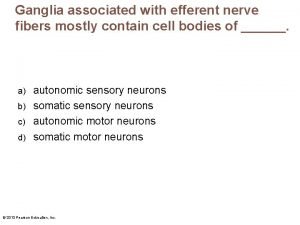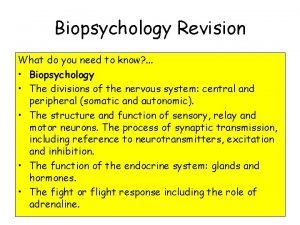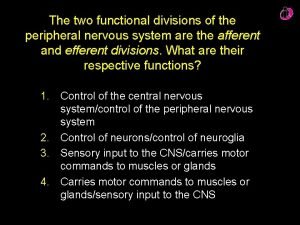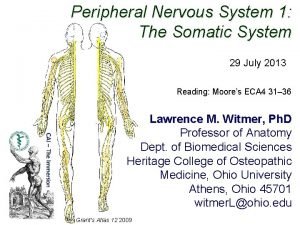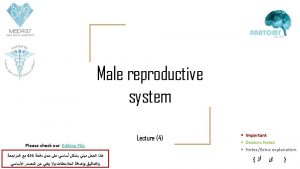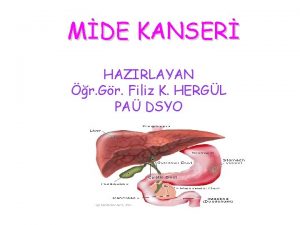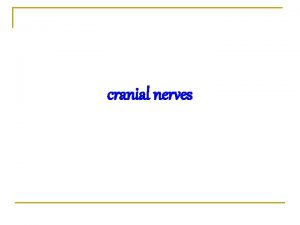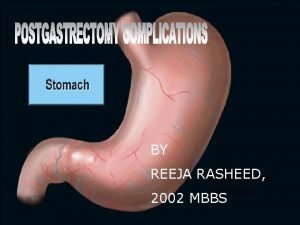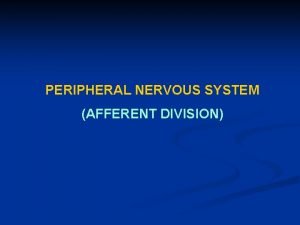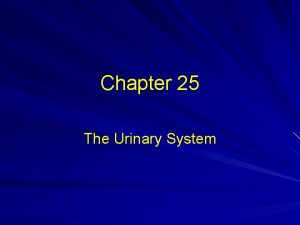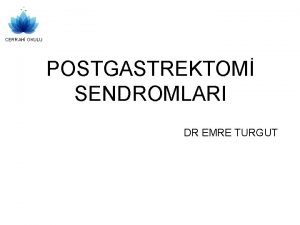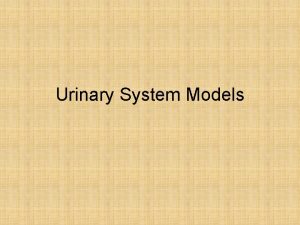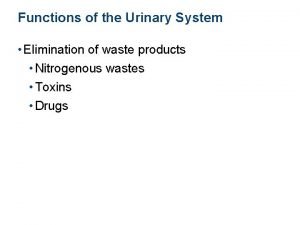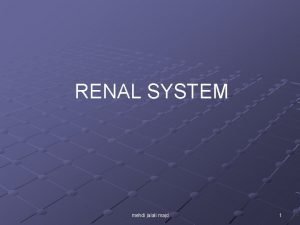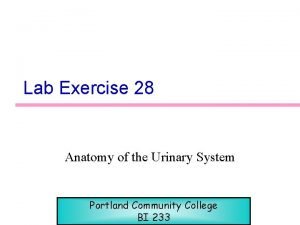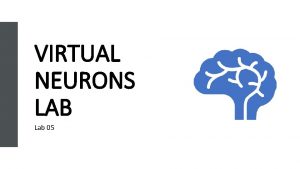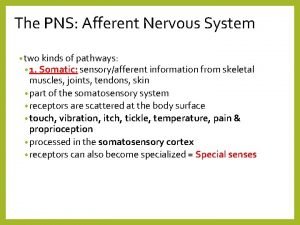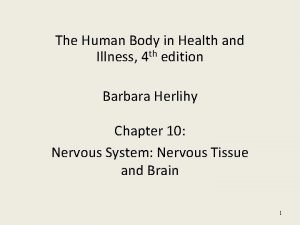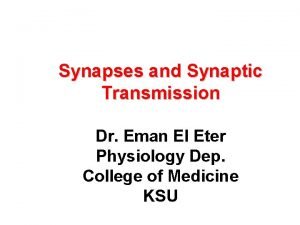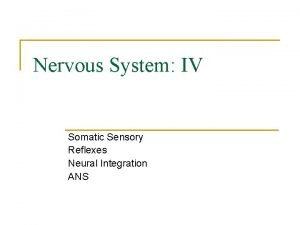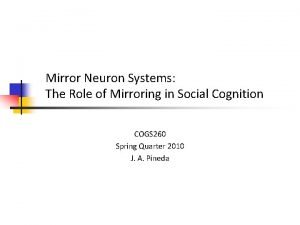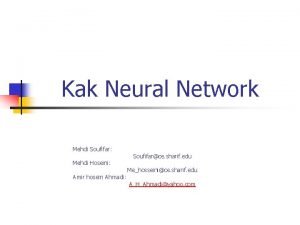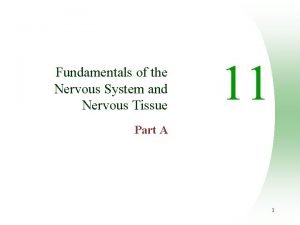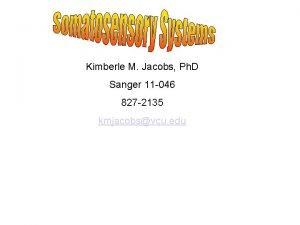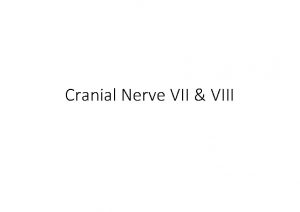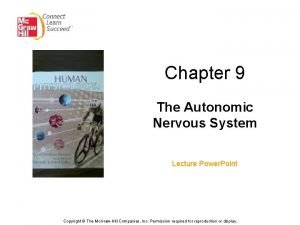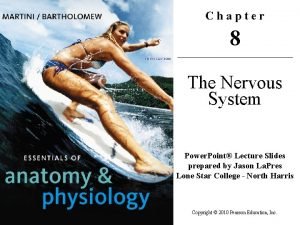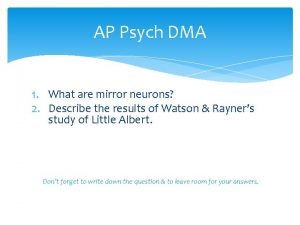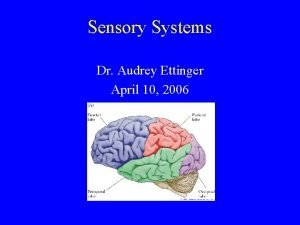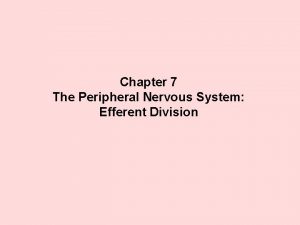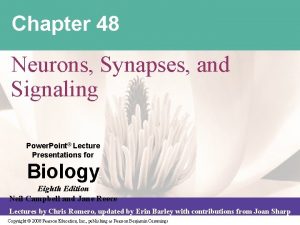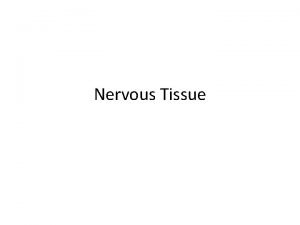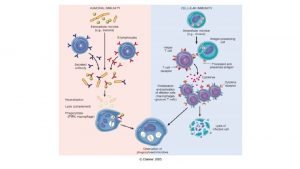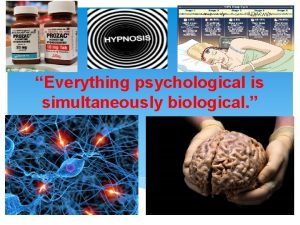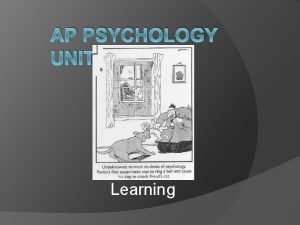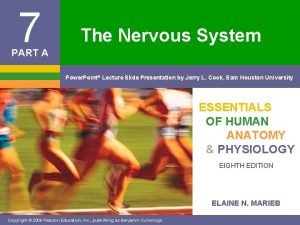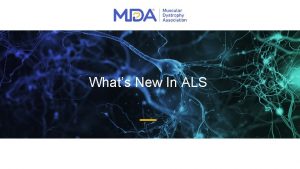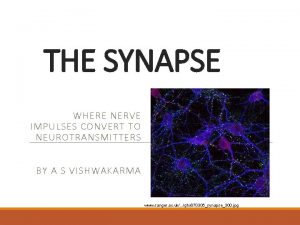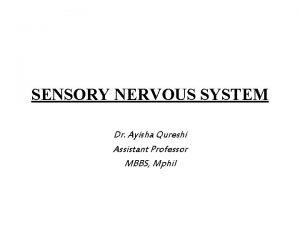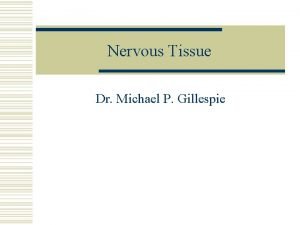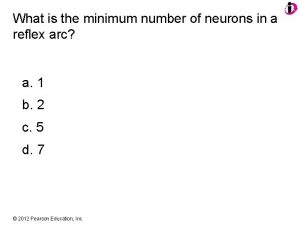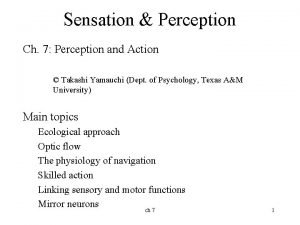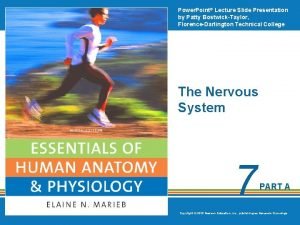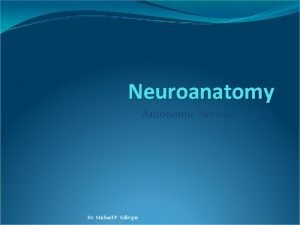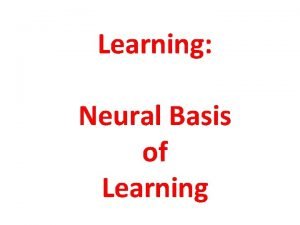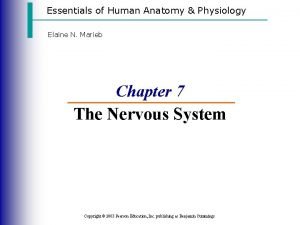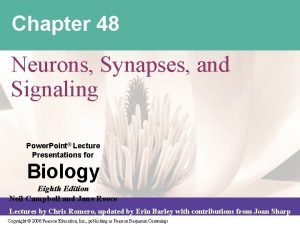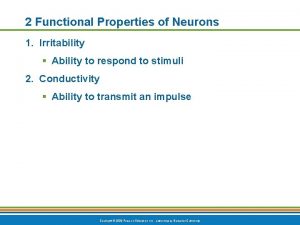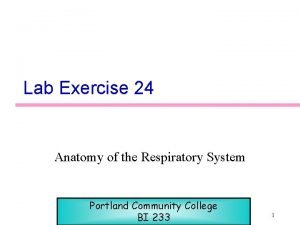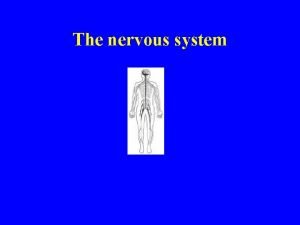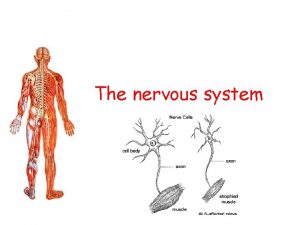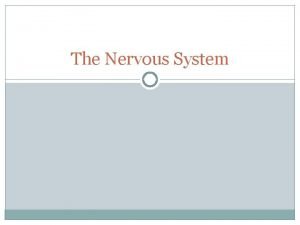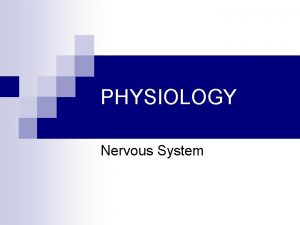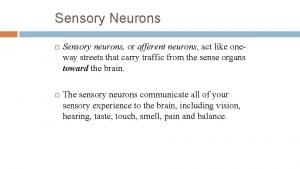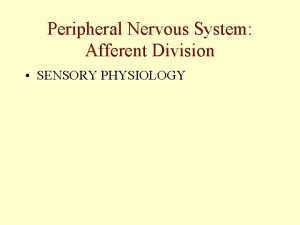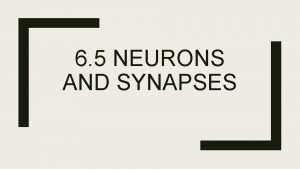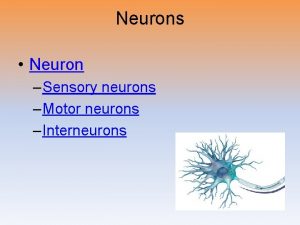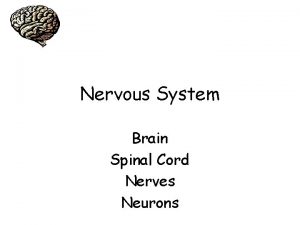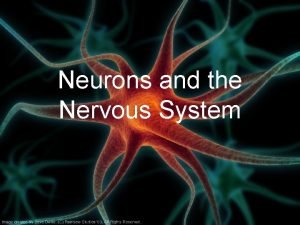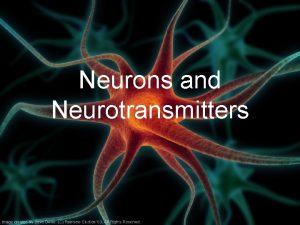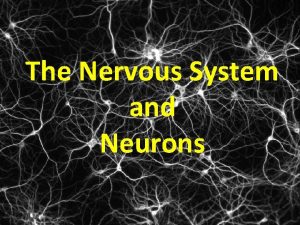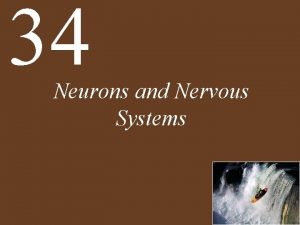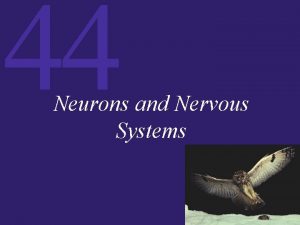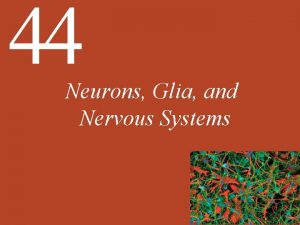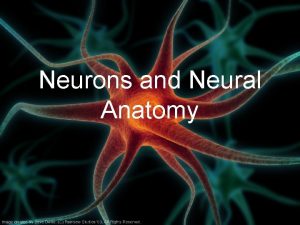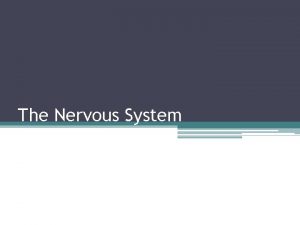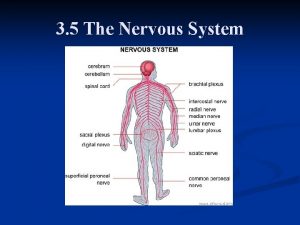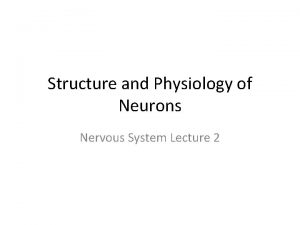PHYSIOLOGY Nervous System Types of Neurons n Afferent



























































































- Slides: 91

PHYSIOLOGY Nervous System


Types of Neurons n Afferent ¨ Sensory n Efferent ¨ Motor n Interneurons also known as association neurons ¨ Between neuron



Classes of Sensory Receptors also known as Neurons Mechano-receptors: mechanical forces- stretching alters membrane permeability (1) hair cells* (deflection = depolarization = AP's) ie. lateral line of fish (mechanoreceptor= neuromasts detect water movement, etc) (2) stretch receptors of muscles (3) equilibrium receptor of inner ear (4) receptors of skin (touch, pain, cold, heat). Chemo-receptors: chemicals sense solutes in solvents, taste, smell Osmo-receptors: of hypothalamus which monitors blood osmotic pressure Photo-receptors: light - eye, eyespots, infrared receptors of snakes, etc. Thermo-receptors: radiant (heat) energy Phono-receptors: sound waves Electro-receptors: detect electric currents. . . electric eels, etc. . Nociceptors: pain receptors. . . naked dendrites of skin (epidermis)

Neuroglial Cells of the CNS

Astrocytes In the CNS only n Most abundant Neuroglial Cell n Formation of Synapses n Plays a role in making exchanges between capillaries and neurons n Helps to form the Blood Brain Barrier n ¨ The BBB protects the brain from intruders

Astrocytes

Microglial Cells n Macrophage ¨ Scavenges n apoptotic cells May go bad causing Alzheimer’s Disease ¨ Excessive secretion of Interleukin-1 ¨ Helps to maintain homeostasis in the brain

Ependymal Cells of the CNS

Ependymal Cells Lines ventricles in the brain and the central cavity of the spinal cord n Cells have cilia n ¨ Used to circulate the cerebrospinal fluid

Oligodendrocyte Cells of the CNS

Oligodendrocyte n Oligodendrocytes ¨ Production of myelin in the CNS ¨ Can cover as many as 60 neurons with myelin


Schwann/Satellite Cells n Schwann Cells ¨ Production of myelin in the PNS ¨ Not able to cover one neuron, must use multiple Schwann Cells ¨ Formation of the Nodes of Ranvier ¨ Produces Neuronal Growth Factor n Satellite Cells ¨ Function unknown



Myelin Sheath n Myelin ¨ Insulates the axon for rapid conduction of action potentials n Nodes of Ranvier ¨ Gray v. White matter in the brain ¨ Multiple Sclerosis is an autoimmune disease


n http: //www. youtube. com/watch? v=Naecv 3 h 868 c


Neuron n Receptive Zone ¨ Where n the Graded Response occurs Cell Body Same information as a regular cell but no centrioles § Amitotic ¨ Contains ligand regulated gates ¨ n Dendrites Projections to help form synapses ¨ Contains ligand regulated gates ¨


Neuron n Conducting Zone ¨ Axon Hillock Begins action potentials n Accumulation of K+ ions n Contains voltage regulated gates for Na+/K+ n ¨ Axon Propagation of action potentials n Contains voltage regulated gates for Na+/K+ n Anterograde vs. Retrograde and Polio n


Secretory Zone ¨ Terminal Boutons Contains voltage regulated gates for Ca+2 n Contains vesicles filled with Neurotransmitter n


Resting Membrane Potential n n -70 m. V Membrane is said to be polarized ¨ Voltage generated by ionic movement through the membrane n Creates a current ¨ ¨ n n Current = Voltage/ Resistance Current generates a Kinetic Energy More Na+ on the outside of the cell More K+ on the inside of the cell ¨ Diffusion down their electrochemical gradient

Resting Membrane Potential n Maintained by the Na+/K+ATPase pumps ¨ Will not allow the neuron to reach equilibrium across the membrane ¨ Actively transports 3 Na+ out of the cell and 2 K+ into the cell



Graded Response n n Short lived Localized changes in membrane potential ¨ Can depolarize or hyperpolarize n Dependent on IPSP or EPSP n the membrane The magnitude of the graded potential varies directly with the stimulus strength ¨ The stronger stimulus causes greater voltage change and the current flows farther n The current dies out within a few millimeters of its origin ¨ Graded response only signals over a very short distance

Graded Response n Ligand sensitive Na+ gates will open with a stimulus ¨ Na+ diffuses into the cell down its electrochemical gradient n Depolarization of the membrane ¨ K+ is repelled down the membrane towards the axon hillock n K+ can diffuse out of the cell because the plasma membrane is very “leaky”

Action Potentials Begins at the axon hillock n Voltage regulated Na+ and K+ gates n ¨ Along with Na+/K+ATPase pumps along the entire membrane n All or nothing response

Action Potentials n Depolarization ¨ -50 m. V due to the accumulation of K+ at the axon hillock triggers an action potential ¨ At -50 m. V Na+ voltage regulated gates open n n Na+ diffuses into the cell down its electrochemical gradient Na+ repels K+ down the membrane ¨ Positive Feedback “on” n The more positive the voltage, due to Na+ diffusing into the cell, the more Na+ gates open. This creates a more positive voltage and more Na+ gates open ¨ Positive Feedback n +30 m. V “off”



Action Potential n Repolarization ¨ At +30 m. V All Na+ gates close quickly n All K+ gates open n ¨ n K+ diffuses out of the cell down its electrochemical gradient K+ gates close slowly at -70 m. V ¨ K+ continues to diffuse out of the cell until it reaches -90 m. V § All K+ gates are closed


Action Potential n Hyperpolarization ¨ At n -90 m. V the Na+/K+ATPase pump turns on Pumps 3 Na+ out and 2 K+ into the cell ¨ Re-establishes resting membrane potential



Propagation of an Action Potential n As the influx of Na+ repels the K+ down the membrane there is an accumulation of K+ ¨ The K+ accumulation with change the membrane voltage to -50 m. V ¨ The occurs when the previous action potential reaches +30 m. V n Repolarization is chasing Depolarization down the membrane

Refractory Period n Absolute refractory ¨ From the opening of the Na+ channels until the Na+ channels begin to reset to their original resting state ¨ Cannot re-stimulate the neuron during this time n Relative refractory ¨ The n n interval following the absolute refractory period Na+ channels have returned to their resting state K+ channels are still open and repolarizing the membrane ¨ Can re-stimulate the neuron during this time with a great stimulus

Synapse Presynaptic neuron n Postsynaptic neuron n Synaptic Cleft n ¨ About n 10 angstroms between neurons Synaptic Vesicles ¨ Filled with neurotransmitter

Synapse Voltage regulated Calcium channels n Membrane reaches -50 m. V due the accumulation of K+ n Calcium channels open n ¨ Calcium gradient n diffuses in down its electrochemical 2 Calcium ions bind to the vesicle ¨ The vesicle fuses with the membrane for exocytosis of the NT

Synapse n The Neurotransmitter crosses the synaptic cleft ¨ NT binds to the receptors on the postsynaptic neuron n Neurotransmitter are removed from the synaptic cleft by: ¨ Reuptake ¨ Phagocytosis ¨ Enzymatic Degradation

Events at the Synapse AP reaches axon terminal Voltage-gated Ca 2+ channels open Ca 2+ entry Ca 2+ = Signal for Neurotransmitter Release Exocytosis of neurotransmitter containing vesicles


1. Axon Diameter

Fig. 8 -18 2. Signal Transduction in Myelinated Axon: Animation Demyelination diseases (E. g. ? )

3 Classes of Neurotransmitters (of 7) 1. Acetyl Choline (ACh) – – 2. Made from Acetyl Co. A and choline Synthesized in axon terminal Quickly degraded by ACh-esterase Cholinergic neurons and receptors – Nicotinic (agonistic) and muscarinic (antagonist) Amines – Serotonin (tryptophane) and Histamine (histidine) ¨ – – – • Dopamine and Norepinephrine (tyrosine) Widely used in brain, role in emotional behavior (NE used in ANS) Adrenergic neurons and receptors - and Gases – 1. SSRI = antidepressants NO (nitric oxide) and CO Others: AA, (e. g. , GABA), lipids, peptides, purines

Neurotransmitters n Cholinergic Receptors ¨ Nicotinic ¨ Muscarinic n Catecholamine ¨ Alpha ¨ Beta

Nicotinic Receptors Stimulated by ACh and nicotine, not stimulated by muscarine. n Found at all ganglionic synapses. n Also found at neuromuscular junctions. n A ligand sensitive gate n

Muscarinic Receptors n n n Stimulated by ACh and muscarine, not stimulated by nicotine. Found at target organs when ACh is released by post-ganglionic neurons (all of parasympathetic, and some sympathetic). Stimulated selectively by Muscarine, Bethanechol. Blocked by Atropine. Stimulation causes: ¨ ¨ ¨ ¨ ¨ Increased sweating. Decreased heart rate. Decreased blood pressure due to decreased cardiac output. Bronchoconstriction and increased bronchosecretion. Contraction of the pupils, and contraction of ciliary body for near vision. Tearing and salivation. Increased motility and secretions of the GI system. Urination and defecation. Engorgement of genitalia.


Catecholamine Receptors n n NE and epinephrine, each act on α- and β-adrenergic receptors Two subclasses of α-adrenergic receptors Activation of α 1 -receptors usually results in a slow depolarization linked to the inhibition of K+ channels ¨ activation of α 2 -receptors produces a slow hyperpolarization due to the activation of a different type of K+ channel. ¨ n n There are three subtypes of β-adrenergic receptor Agonists and antagonists of adrenergic receptors ¨ β-blocker propanolol (Inderol®). n However, most of their actions are on smooth muscle receptors, particularly the cardiovascular and respiratory systems

α 1 adrenergic receptors Mainly involved with contraction of smooth muscle n G protein, c. AMP action n

α 2 adrenergic receptors n Three types of receptors ¨ α 2 A, n α 2Β, and α 2 C These receptors have a critical role in regulating neurotransmitter release from sympathetic nerves and from adrenergic neurons in the central nervous system

β 1 adrenergic receptors n Specific actions of the β 1 receptor include: ¨ Increases n cardiac output by raising heart rate and increasing the volume expelled with each beat (increased ejection fraction). ¨ Renin release from juxtaglomerular cells. ¨ Lipolysis in adipose tissue.

β 2 adrenergic receptors n Specific actions of the β 2 receptor include: ¨ Smooth muscle relaxation, e. g. in bronchi. ¨ Relax non-pregnant uterus. ¨ Relax detrusor urinae muscle of bladder wall ¨ Dilate arteries to skeletal muscle ¨ Glycogenolysis and gluconeogenesis ¨ Contract sphincters of GI tract ¨ Thickened secretions from salivary glands. ¨ Inhibit histamine-release from mast cells ¨ Increase renin secretion from kidney

β 3 adrenergic receptors n Specific actions of the β 3 receptor include: ¨ Enhancement ¨ CNS effects of lipolysis in adipose tissue.

Neurological Communication There’s no one-to-one communication between neurons n May be as many as 500 neurons communicating with a single neuron n ¨ Convergence ¨ Divergence

Postsynaptic Responses Can lead to either EPSP or IPSP Any one synapse can only be either excitatory or inhibitory Fast synaptic potentials Opening of chemically gated ion channel Rapid & of short duration Slow synaptic potentials Involve G-proteins and 2 nd messengers Can open or close channels or change protein composition of neuron

Integration of Neural Information Transfer Multiple graded potentials are integrated at axon hillock to evaluate necessity of AP 1. Spatial Summation: stimuli from different locations are added up 2. Temporal Summation: sequential stimuli added up

1. Spatial Summation

2. Temporal Summation





General Adaptation Syndrome

General Adaptation Syndrome n Hans Selye Alarm Phase ¨A stressor disturbs homeostasis ¨ Cerebral Cortex alerts Hypothalamus which alerts the Sympathetic Nervous System




General Adaptation Syndrome n Resistance Phase ¨ Body reacts to stressor ¨ Attempts to return to homeostasis ¨ Down and Up Regulation

General Adaptation Syndrome n Exhaustion Phase ¨ Physical and Psychological energy is sapped n Atypical depression ¨ n n n Mood disorder Dysphoria -generally characterized as an unpleasant or uncomfortable mood, such as sadness (depressed mood), anxiety, irritability, or restlessness Serious illness(es) may occur Hits person at weakest genetic point ¨ ¨ Autoimmune Disease(s) Endorphins Increase and inhibit the immune system response

General Adaptation Syndrome n Final Phase is Death








Dermatomes

Dermatomes

Bipolar Neuron n Two processes ¨ An axon and a dendrite n They extend in opposite directions ¨ Used for sensory organs n n Olfactory neurons Retina

Unipolar Neurons n n Presence of only a single axon, branching at the terminal end. True unipolar neurons not found in adult human; common in human embryos and invertebrates
 Ganglia associated with efferent fibers
Ganglia associated with efferent fibers Fundamentals of the nervous system and nervous tissue
Fundamentals of the nervous system and nervous tissue Sensory input and motor output
Sensory input and motor output Neuronal processes
Neuronal processes Biopsychology revision
Biopsychology revision Nervous system and digestive system
Nervous system and digestive system Endocrine system vs nervous system
Endocrine system vs nervous system Mechanism of action of hormones
Mechanism of action of hormones Endocrine system
Endocrine system Hypopolarization
Hypopolarization Kornea refleksi afferenti
Kornea refleksi afferenti Visceral afferent vs efferent
Visceral afferent vs efferent Cremasteric reflex
Cremasteric reflex Gastrojejunokolik fistül nedir
Gastrojejunokolik fistül nedir Cremasteric reflex afferent and efferent
Cremasteric reflex afferent and efferent Oncotic pressure vs hydrostatic
Oncotic pressure vs hydrostatic Afferent arteriole
Afferent arteriole Afferent cranial nerves
Afferent cranial nerves Billroth 1
Billroth 1 Rapd relative afferent pupillary defect
Rapd relative afferent pupillary defect Afférent et efférent
Afférent et efférent Afferent division
Afferent division Pars plana pars plicata
Pars plana pars plicata Chapter 25 the urinary system
Chapter 25 the urinary system Afferent ans sendromu
Afferent ans sendromu Bowmans capsule
Bowmans capsule Images of a bladder
Images of a bladder Bowmans capsule
Bowmans capsule Afferent arteriole
Afferent arteriole Starlingova rovnováha
Starlingova rovnováha Types of physiology
Types of physiology Virtual neurons
Virtual neurons Type 1 cutaneous mechanoreceptors
Type 1 cutaneous mechanoreceptors Polarized vs depolarized neurons
Polarized vs depolarized neurons 1st order 2nd order 3rd order neurons
1st order 2nd order 3rd order neurons Types of synapse
Types of synapse Input neurons
Input neurons Somatic motor association area
Somatic motor association area Inverse stretch reflex
Inverse stretch reflex Proprioception autism
Proprioception autism Mirror neuron
Mirror neuron Input neurons
Input neurons Label the different types of neuronal pools in the figure.
Label the different types of neuronal pools in the figure. Corticospinal tract
Corticospinal tract Fourth order neurons
Fourth order neurons Vestibulocochlear nerve nuclei
Vestibulocochlear nerve nuclei Adrenergic receptors sympathetic or parasympathetic
Adrenergic receptors sympathetic or parasympathetic Figure 8-2 neurons and neuroglia
Figure 8-2 neurons and neuroglia Mirror neurons ap psych
Mirror neurons ap psych Audrey ettinger
Audrey ettinger What are neurons composed of
What are neurons composed of Junction between two communicating neurons
Junction between two communicating neurons Efferent motor neurons
Efferent motor neurons Chapter 48 neurons synapses and signaling
Chapter 48 neurons synapses and signaling Unipolar neurons are found in
Unipolar neurons are found in Myelinzation
Myelinzation Everything psychological is simultaneously biological
Everything psychological is simultaneously biological Characteristics of sensory neurons
Characteristics of sensory neurons Latent learning
Latent learning Unipolar neurons are found in
Unipolar neurons are found in Upper motor neurons
Upper motor neurons Neurons
Neurons Arthropod nervous system
Arthropod nervous system Receptive fields of sensory neurons
Receptive fields of sensory neurons Sympathetic nervous systems
Sympathetic nervous systems Pruning neurons
Pruning neurons Potencial de acción
Potencial de acción Language
Language Mirror neurons
Mirror neurons What is the minimum number of neurons in a reflex arc
What is the minimum number of neurons in a reflex arc Mirror neurons
Mirror neurons Functional classification of neurons
Functional classification of neurons Autonomic motor neurons regulate visceral activities by
Autonomic motor neurons regulate visceral activities by Wikipedia
Wikipedia Image of neuron
Image of neuron Chapter 48 neurons synapses and signaling
Chapter 48 neurons synapses and signaling Irritability of neurons
Irritability of neurons Anatomy and physiology unit 7 cardiovascular system
Anatomy and physiology unit 7 cardiovascular system Trachea
Trachea Picture of human respiratory system
Picture of human respiratory system Male vs female skeleton pelvis
Male vs female skeleton pelvis Chemical messengers of the nervous system
Chemical messengers of the nervous system Bristle worm phylum
Bristle worm phylum The nervous system is made up of
The nervous system is made up of Three basic functions of the nervous system
Three basic functions of the nervous system Nervous system learning objectives
Nervous system learning objectives Chapter 7 the nervous system
Chapter 7 the nervous system Stimulus in nervous system
Stimulus in nervous system Neuron bundle
Neuron bundle Nerve ganglia
Nerve ganglia Nervous system def
Nervous system def Spinal nerves
Spinal nerves
